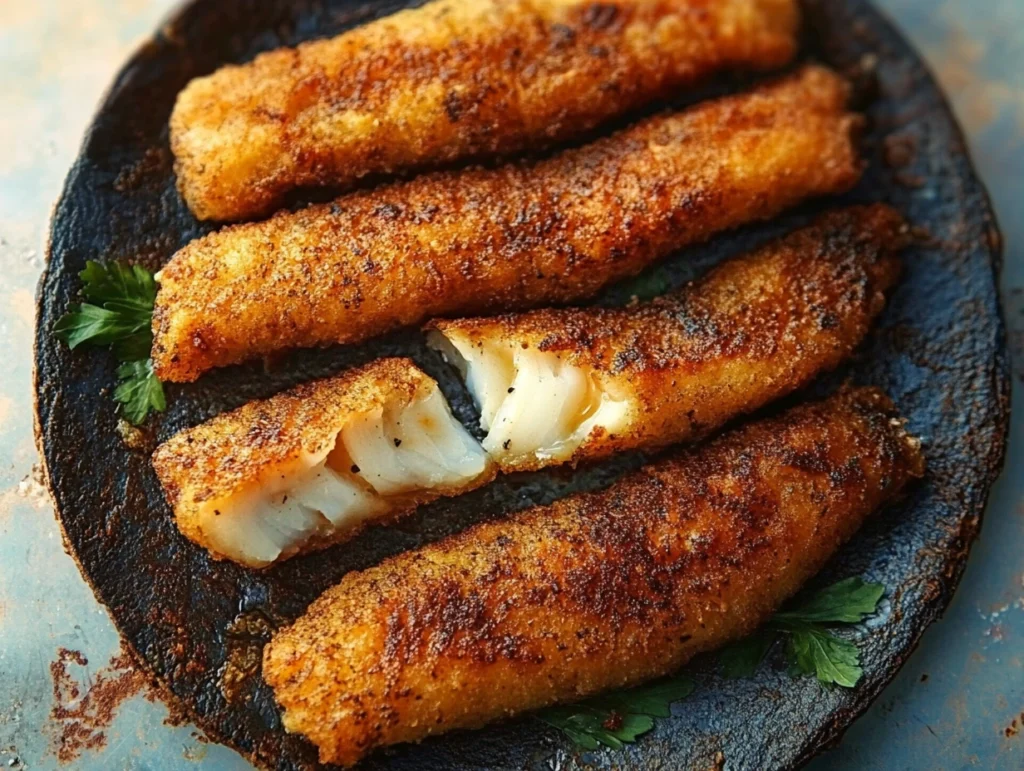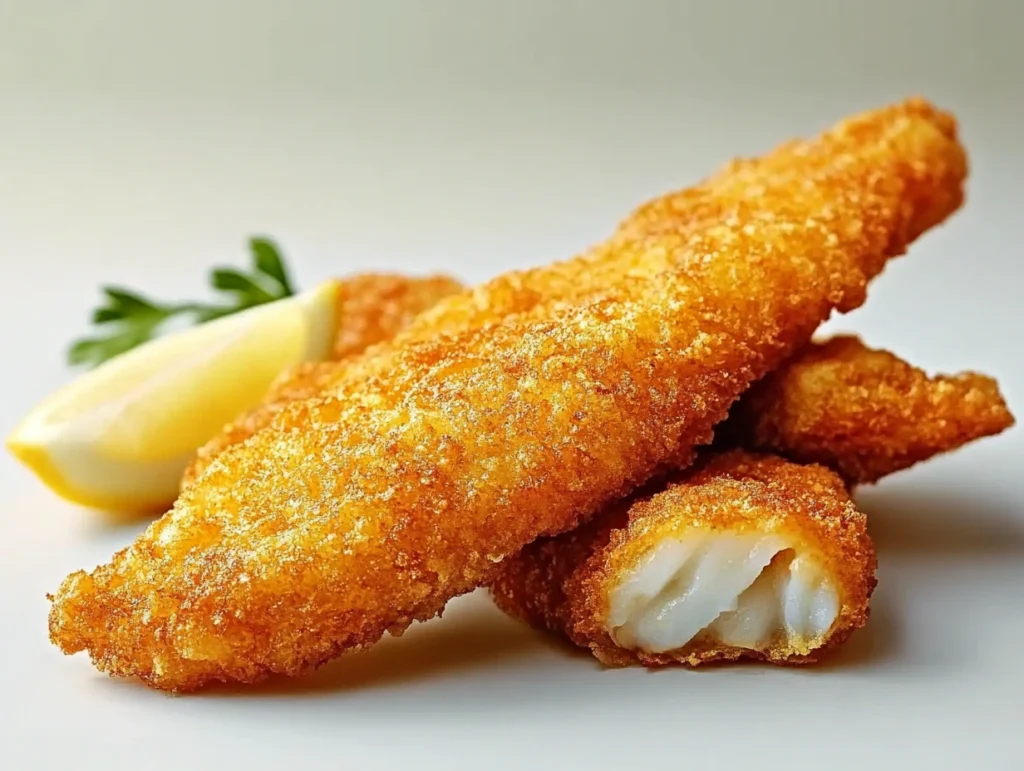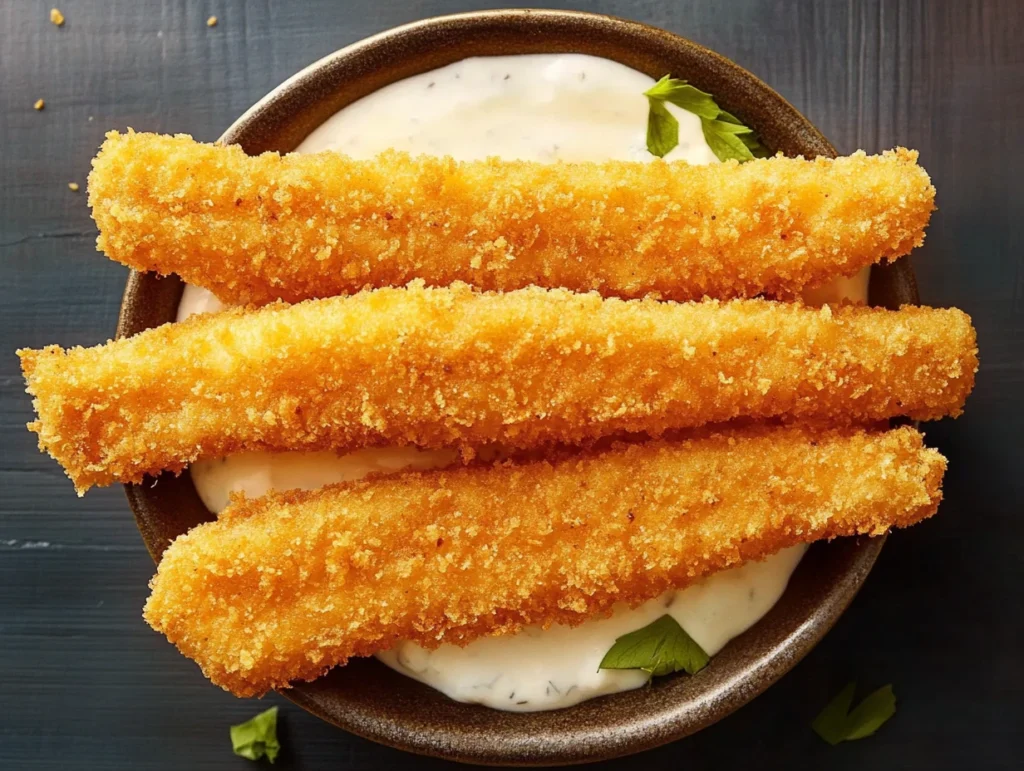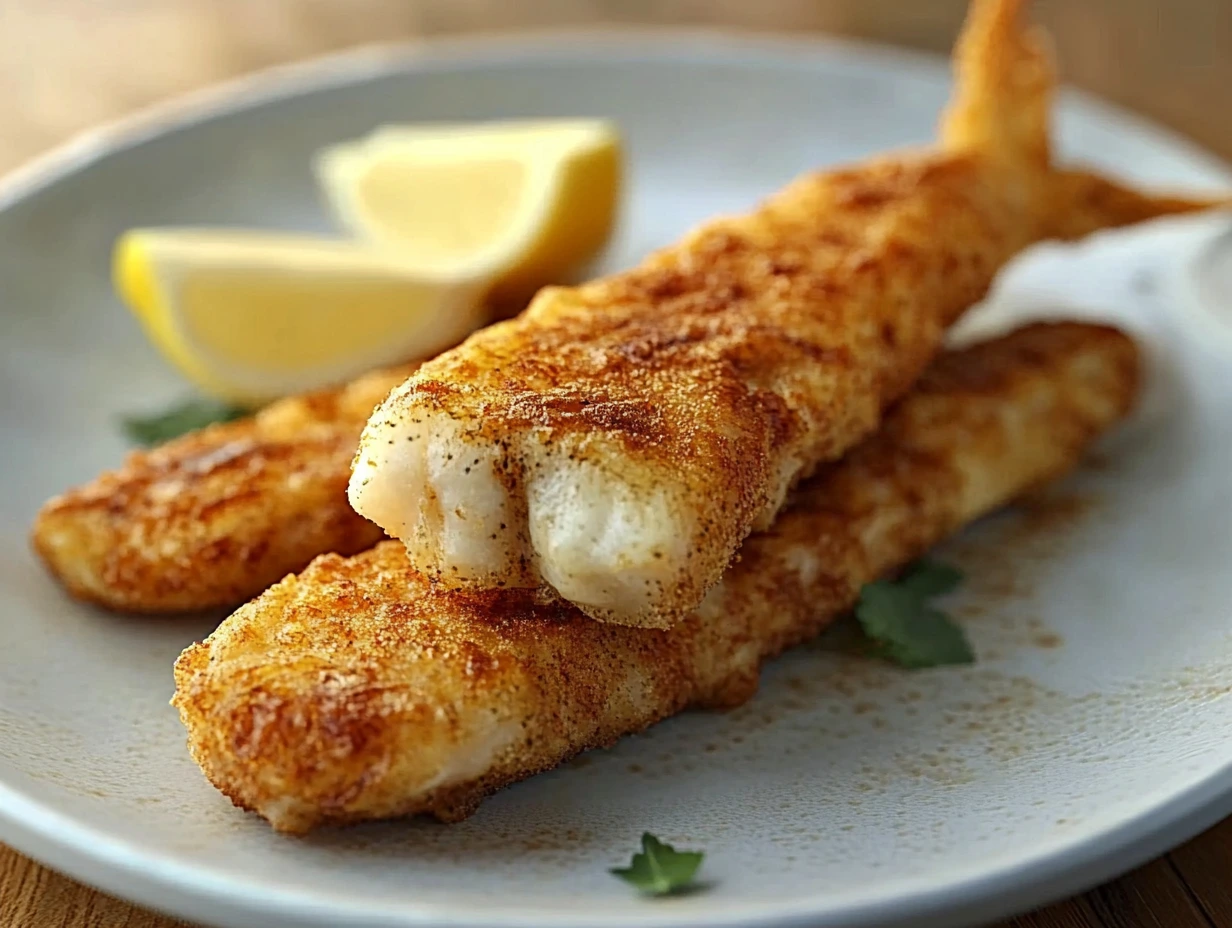Fish sticks are a beloved dish for many, offering a crispy, golden exterior with tender, flaky fish inside. This recipe for homemade fish sticks takes this classic comfort food to the next level, delivering unparalleled freshness and flavor. With simple ingredients and straightforward preparation, homemade fish sticks are a healthier and tastier alternative to their store-bought counterparts, making them a hit with both kids and adults alike.

Table of Contents
Why Make Homemade Fish Sticks?
While store-bought fish sticks are convenient, making them from scratch has many benefits.
1. Freshness and Flavor
Homemade fish sticks are made with fresh fish, which provides superior flavor and texture. You control the ingredients, ensuring a dish free from artificial preservatives or excessive sodium.
2. Healthier Ingredients
By using whole fish fillets and coating them with your preferred breading, you can create a healthier version of this family favorite. Opt for whole-grain breadcrumbs or panko for added fiber, and bake instead of fry for a lower-fat option.
3. Customization
Homemade fish sticks allow for endless variations. Season the coating with spices or herbs to suit your taste, or experiment with different types of fish to keep things exciting.
Types of Fish for Fish Sticks
Choosing the right type of fish is key to achieving the perfect fish stick. The fish should be firm, flaky, and mild-tasting to complement the crispy coating.
1. Cod
Cod is a classic choice, known for its mild flavor and firm, flaky texture. It holds up well during cooking and provides a traditional taste reminiscent of restaurant-style fish sticks.
2. Pollock
Pollock is an affordable and sustainable option. It’s a popular choice for frozen fish products but tastes even better when prepared fresh at home.
3. Tilapia
Tilapia is another mild-flavored fish that works well in fish sticks. It’s budget-friendly and widely available, making it a convenient option.
4. Haddock
Haddock offers a slightly sweeter flavor, ideal for those who enjoy a touch of natural richness in their fish sticks. Its firm texture makes it easy to bread and cook.
5. Halibut
For a premium option, halibut delivers a luxurious, buttery texture and flavor. Though pricier, it’s perfect for special occasions or when you want to impress.
Tools You’ll Need
Making fish sticks at home requires some basic kitchen tools. Here’s what you’ll need:
- Cutting Board and Knife: For cutting the fish into uniform sticks.
- Mixing Bowls: To prepare the breading and egg mixture.
- Tongs or Fork: For dipping the fish into the breading and placing it into the frying pan.
- Baking Sheet or Plate: To arrange the breaded fish sticks before cooking.
- Nonstick Frying Pan or Deep Fryer: For frying the fish sticks to golden perfection.
- Wire Rack: To drain excess oil while keeping the fish sticks crispy.
- Paper Towels: To pat dry the fish and absorb excess oil after frying.
Ingredients for Fish Sticks
Here’s a comprehensive list of ingredients you’ll need, along with some alternatives to suit different tastes and dietary preferences.
Main Ingredients
- Fish Fillets (1 lb): Cod, pollock, tilapia, haddock, or halibut.
- All-Purpose Flour (½ cup): For the initial coating. Substitute with gluten-free flour if needed.
- Eggs (2): To help the breading stick. Buttermilk or plant-based milk with a binding agent can also work.
- Breadcrumbs (1 cup): Use panko for extra crunch or whole-grain breadcrumbs for a healthier option.
- Seasonings: Salt, pepper, paprika, garlic powder, onion powder, and optional cayenne for a spicy kick.
Optional Add-Ons
- Grated Parmesan: Adds a savory depth to the breading.
- Fresh Herbs: Such as parsley or dill, for garnish.
- Lemon Wedges: For serving, to enhance the fish’s flavor.
Step-by-Step Instructions
Follow these steps to create perfectly crispy and delicious fish sticks.
Preparing the Fish
- Pat Dry: Use paper towels to pat the fish fillets dry. This helps the coating stick better.
- Cut into Sticks: Slice the fillets into uniform strips, about 1-inch wide and 3-4 inches long, for even cooking.
Breading Process
- Set Up a Breading Station: Arrange three bowls – one with flour, one with beaten eggs, and one with breadcrumbs mixed with seasonings.
- Coat the Fish:
- Dredge each piece of fish in flour, shaking off excess.
- Dip it into the beaten egg, ensuring it’s fully coated.
- Roll it in the breadcrumb mixture, pressing gently to ensure the coating sticks.
- Rest the Breaded Fish: Place the breaded fish sticks on a baking sheet lined with parchment paper. Let them sit for a few minutes to set the coating.
Frying Techniques
- Heat the Oil: Pour enough oil into a nonstick frying pan to submerge the bottom half of the fish sticks. Heat to 350°F (175°C).
- Cook in Batches: Fry the fish sticks in small batches to avoid overcrowding the pan. Cook for 2-3 minutes on each side, or until golden brown and crispy.
- Drain and Serve: Transfer cooked fish sticks to a wire rack lined with paper towels. Serve immediately with your favorite dipping sauces and lemon wedges.
Pro Tip: For a healthier option, bake the fish sticks at 400°F (200°C) for 15-20 minutes, flipping halfway through, until crispy and cooked through.

Baking and Air-Frying Alternatives
For a healthier spin on fish sticks, consider these alternative preparation methods:
Baking
- Preheat the Oven: Set your oven to 400°F (200°C). Line a baking sheet with parchment paper or lightly grease it.
- Arrange the Fish Sticks: Place the breaded fish sticks on the baking sheet, leaving some space between them.
- Optional Oil Spray: Lightly spray the fish sticks with cooking oil for extra crispiness.
- Bake: Cook for 15-20 minutes, flipping halfway through. The fish sticks should be golden brown and cooked through (internal temperature of 145°F/63°C).
Air-Frying
- Preheat the Air Fryer: Set the temperature to 375°F (190°C).
- Arrange the Fish Sticks: Place the breaded fish sticks in the air fryer basket in a single layer. Avoid overcrowding to ensure even cooking.
- Cook: Air fry for 10-12 minutes, flipping halfway. The fish sticks should be crispy and golden.
- Check for Doneness: Use a food thermometer to confirm the internal temperature has reached 145°F (63°C).
Serving Suggestions
Homemade fish sticks are versatile and pair well with various sides and sauces to create a complete meal.
Side Dishes
- Classic Pairings: French fries, coleslaw, or potato wedges.
- Healthy Options: Steamed vegetables, a fresh green salad, or roasted sweet potatoes.
- Grain-Based Sides: Rice pilaf, quinoa, or couscous for a hearty meal.
Sauces
- Tartar Sauce: A classic choice with mayonnaise, pickles, and a splash of lemon juice.
- Ketchup or Cocktail Sauce: For a simple and familiar dip.
- Spicy Aioli: A blend of mayonnaise, garlic, and hot sauce for a kick.
- Honey Mustard: A sweet and tangy option that pairs beautifully with fish.
- Yogurt-Based Dip: Mix Greek yogurt with dill, lemon juice, and a pinch of salt for a light, refreshing option.
Tips for Perfect Fish Sticks
Master the art of making fish sticks with these expert tips:
- Choose the Right Fish: Opt for firm, mild-tasting fish like cod, pollock, or haddock for the best results.
- Dry the Fish Thoroughly: Patting the fish dry helps the breading adhere better.
- Season Generously: Add spices or herbs to the breading for enhanced flavor.
- Use Panko Breadcrumbs: Panko provides a crunchier texture compared to regular breadcrumbs.
- Chill Before Cooking: After breading, refrigerate the fish sticks for 10-15 minutes. This helps the coating stay intact during cooking.
- Maintain Oil Temperature: For frying, keep the oil at a steady 350°F (175°C) to ensure even cooking without greasiness.
- Test for Doneness: Always check that the fish is fully cooked to an internal temperature of 145°F (63°C).
- Work in Batches: Avoid overcrowding the frying pan or air fryer to ensure crisp, evenly cooked fish sticks.
Health Benefits of Fish Sticks
Homemade fish sticks aren’t just delicious—they can also be a nutritious addition to your diet when prepared thoughtfully.
1. High-Quality Protein
Fish is an excellent source of lean protein, which supports muscle repair and overall health. A single serving provides ample protein to keep you full and energized.
2. Rich in Omega-3 Fatty Acids
Many fish, such as cod and haddock, are rich in omega-3 fatty acids. These healthy fats promote brain function, heart health, and reduced inflammation.
3. Essential Vitamins and Minerals
Fish contains important nutrients like vitamin D, vitamin B12, selenium, and iodine, which contribute to bone health, red blood cell production, and thyroid function.
4. Lower Sodium and Additives
Compared to store-bought options, homemade fish sticks allow you to control sodium levels and avoid preservatives or artificial additives.
Common Mistakes to Avoid
Avoid these common pitfalls for perfectly crispy and flavorful fish sticks:
1. Using Wet Fish
Skipping the step of patting the fish dry can lead to a soggy coating that doesn’t stick. Always dry the fillets thoroughly before breading.
2. Overcrowding the Pan or Air Fryer
Cooking too many fish sticks at once can lower the oil temperature or prevent even air circulation, resulting in unevenly cooked or soggy fish. Cook in batches for the best results.
3. Skipping the Chill Step
Letting the breaded fish sit in the fridge for 10-15 minutes before cooking helps the coating adhere better and stay intact.
4. Inconsistent Cutting
Unevenly sized fish sticks can result in uneven cooking. Take care to cut the fillets into uniform strips.
5. Using Too Much or Too Little Oil
For frying, use just enough oil to submerge the bottom half of the fish sticks. Excess oil can make them greasy, while too little may cause uneven cooking.
6. Under-Seasoning
Seasoning the breadcrumbs, flour, and fish is crucial for a flavorful result. Don’t be afraid to experiment with spices and herbs.

Nutritional Information
The nutritional profile of homemade fish sticks can vary based on ingredients and cooking methods. Below is an approximate breakdown for one serving (4-5 fish sticks, baked):
- Calories: 220-250 kcal
- Protein: 20-25 g
- Carbohydrates: 15-20 g (from breadcrumbs and flour)
- Fats: 8-10 g (lower for baked, higher for fried)
- Saturated Fat: 1-2 g
- Omega-3 Fatty Acids: 200-400 mg (depending on the fish used)
- Fiber: 1-2 g (with whole-grain breadcrumbs)
- Sodium: 300-400 mg (adjustable based on seasoning)
Tips for Healthier Fish Sticks
- Choose Whole-Grain Breadcrumbs: Add fiber and nutrients.
- Bake or Air-Fry: Reduce fat content while maintaining crispiness.
- Limit Added Salt: Use herbs and spices to enhance flavor naturally.
- Serve with Healthy Sides: Pair with vegetables or a fresh salad for a balanced meal.
Frequently Asked Questions (FAQs) About Fish Sticks
Here are answers to some common questions about making, storing, and enjoying fish sticks.
1. Can I use frozen fish for homemade fish sticks?
Yes! Frozen fish works well for fish sticks, but ensure you thaw it completely and pat it dry before use. Excess water can make the breading soggy and prevent it from adhering properly.
2. How do I prevent the breading from falling off?
To ensure the breading stays intact:
- Pat the fish fillets dry before breading.
- Follow the proper breading process (flour → egg → breadcrumbs).
- Chill the breaded fish sticks in the fridge for 10-15 minutes before cooking.
3. What’s the best oil for frying fish sticks?
Use a neutral oil with a high smoke point, such as:
- Vegetable oil
- Canola oil
- Peanut oil
These oils ensure crispy results without overpowering the flavor of the fish.
4. How can I make fish sticks gluten-free?
To make gluten-free fish sticks:
- Use gluten-free flour or cornstarch for dredging.
- Replace breadcrumbs with gluten-free breadcrumbs, crushed rice crackers, or ground nuts.
5. Can I freeze homemade fish sticks?
Yes, homemade fish sticks freeze well! Follow these steps:
- Bread the fish sticks as instructed, but don’t cook them.
- Arrange them in a single layer on a baking sheet and freeze until firm.
- Transfer the frozen fish sticks to a resealable freezer bag or container.
- When ready to cook, bake or air-fry directly from frozen, adding a few extra minutes to the cooking time.
6. How long can cooked fish sticks be stored?
Cooked fish sticks can be stored in an airtight container in the refrigerator for up to 3 days. Reheat them in the oven or air fryer to restore their crispiness.
7. Can I make fish sticks dairy-free?
Yes! Simply replace the eggs in the breading process with a dairy-free alternative, such as:
- A mixture of plant-based milk (like almond or soy) and cornstarch.
- A vegan egg substitute, like aquafaba or flaxseed gel.
8. What dipping sauces pair well with fish sticks?
Fish sticks are versatile and pair well with a variety of sauces:
- Classic tartar sauce
- Ketchup
- Spicy aioli
- Sweet chili sauce
- Yogurt-based dips with dill and lemon
9. Are fish sticks healthy?
Homemade fish sticks can be a healthy meal when prepared with fresh ingredients and baked or air-fried instead of deep-fried. They are high in protein, low in saturated fat, and a good source of omega-3 fatty acids.
10. What’s the best way to reheat fish sticks?
To maintain their crispiness:
- Oven: Preheat to 375°F (190°C) and bake for 8-10 minutes.
- Air Fryer: Reheat at 350°F (175°C) for 5-7 minutes.
Avoid microwaving, as it can make the fish sticks soggy.
When discussing alternative cooking methods, reference the Air Fryer Red Potatoes Recipe to emphasize how air frying enhances crispiness with minimal oil. If you’re highlighting meal pairings, suggest pairing fish sticks with sides like the Fried Zucchini Recipe for a balanced and flavorful plate. Lastly, under tips for maintaining breading, link to the How Do You Keep Breading from Falling Off Chicken Parmesan? article for additional insights on perfect breading techniques.
Conclusion
Homemade fish sticks are a delightful way to enjoy a classic comfort food with a personal touch. By using fresh ingredients, choosing healthier cooking methods like baking or air-frying, and incorporating expert tips, you can create a meal that’s not only delicious but also nutritious. Whether paired with your favorite dipping sauces, served alongside crispy sides, or tailored to dietary preferences, fish sticks offer endless possibilities for customization.
Take the plunge into making your own fish sticks today, and transform a familiar dish into a gourmet experience that will impress your family and friends. Enjoy the satisfaction of knowing you’ve created something truly special, right in your own kitchen!

